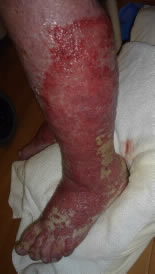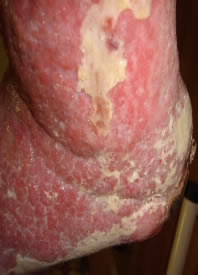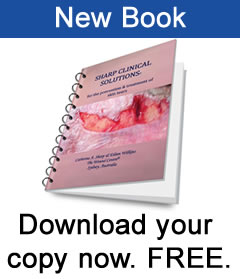Managing the chronic wound environment with Hydration Response Technology; Excerpt from a case study
Mr S. an elderly, obese, gentleman was admitted for assessment and management of bilateral lateral malleolar leg ulcers. The patient’s legs were grossly oedematous with virtually circumferential, severe, bilateral, sloughy, malodorous, maceration of the peri-wound skin. (Figures 1-3)
 |
 |
|
| Fig. 1 Left leg Day 0 | Fig. 2 Close-up of Left lateral malleolus |
The production of exudates was unrelenting so that dressings and bed linen required at least daily changes and sometimes night changes as well. Dressing change took more than an hour each time to complete, often requiring the assistance of a second nurse.
If a (chronic) wound is to make progress then the barriers to healing need to be identified and addressed. The persistent inflammation that is found in chronic wounds is a consequence of elevated levels of pro-inflammatory cytokines, proteases and neutrophils2. This is often accompanied by elevated production of exudate. The high levels of exudate combined with the pro-inflammatory mediators result in a detrimental effect on healing, including wound enlargement and damage to the peri-wound skin such as maceration and excoriation3. It has been suggested that the wound bed preparation (WBP) model may assist in overcoming these barriers to healing when targeted therapeutic measures are initiated1.
Hydration Response Technology
A recent publication by Evans4 shows how sorbion sachet S utilises the concept of Hydration Response Technology (HRT) and specifically its value in managing infection in a recalcitrant pressure ulcer. Hydration Response Technology was created specifically to meet the challenge of wounds which produce moderate to high levels of exudates.
Clinical performance and related evidence
Hydration Response Technology using sorbion sachet S enables effective wound bed preparation and can lead to a significant reduction of overall treatment costs4,5,6,7. Efficient management of exudates extends beyond mere absorption and includes,:4, 5, 8, 9
|
Table 1
Read the full article and see more photographs of the progress of this gentleman’s leg ulceration in Sharp C.A. Managing the wound environment with Hydration Response Technology. Wounds UK 2010 Vol 6, No 2 and on the website http://www.sorbion.com/en/clinical-data/
References 1. Schultz GS, Barillo DJ, Mozingo DW, et al. Wound bed preparation and a brief history of TIME. Wound Repair and Regeneration 2004; 1(1):19-32. 2. Wolcott RD, Rhoads DD, Dowd SE. Biofilms and chronic wound inflammation. Journal of Wound Care 2008; 17(8):333-341. 3. Nelson A. Is Exudate a Clinical Problem. In: (Eds.) Cherry, G., Harding, K. Proceedings, Joint Meeting, European Wound Management Association and European Tissue Repair Society. Management of Wound Exudate. London:. Churchill Communications Europe 1997. 4. Evans J. Hydration response technology and managing infection. Journal of Community Nursing 2010; 24(1):15-16. 5. Romanelli M, Dini V, Bertone M. A pilot study evaluating the wound and skin care performances of the Hydration Response Technology dressing: a new concept of debridement. Journal of Wound Technology 2009; 5:1-3. 6. Chadwick P. The use of sorbion sachet S in the treatment of a highly exuding diabetic foot wound. The Diabetic Foot Journal 2008; 11(4):183-186. 7. Cutting KF, Acton C, Beldon P, et al. Clinical evaluation of a new high absorbency dressing. EWMA conference, Lisbon 2008; 14-16 May. 8. Cutting KF. Managing wound exudate using a super-absorbent polymer dressing: a 53-patient clinical evaluation. Journal of Wound Care 2009; 18(5):200-205. 9. Armitage M, Macaskill C. Simplifying the management of complex chronic leg ulcers. Poster presentation – Wounds-UK 2009; Harrogate.


Hi, after reading this remarkable post i am too cheerful
to share my experience here with friends.
I’m really impressed with your writing skills as well as with the layout on your blog. Is this a paid theme or did you modify it yourself? Either way keep up the nice quality writing, it is rare to see a nice blog like this one today.